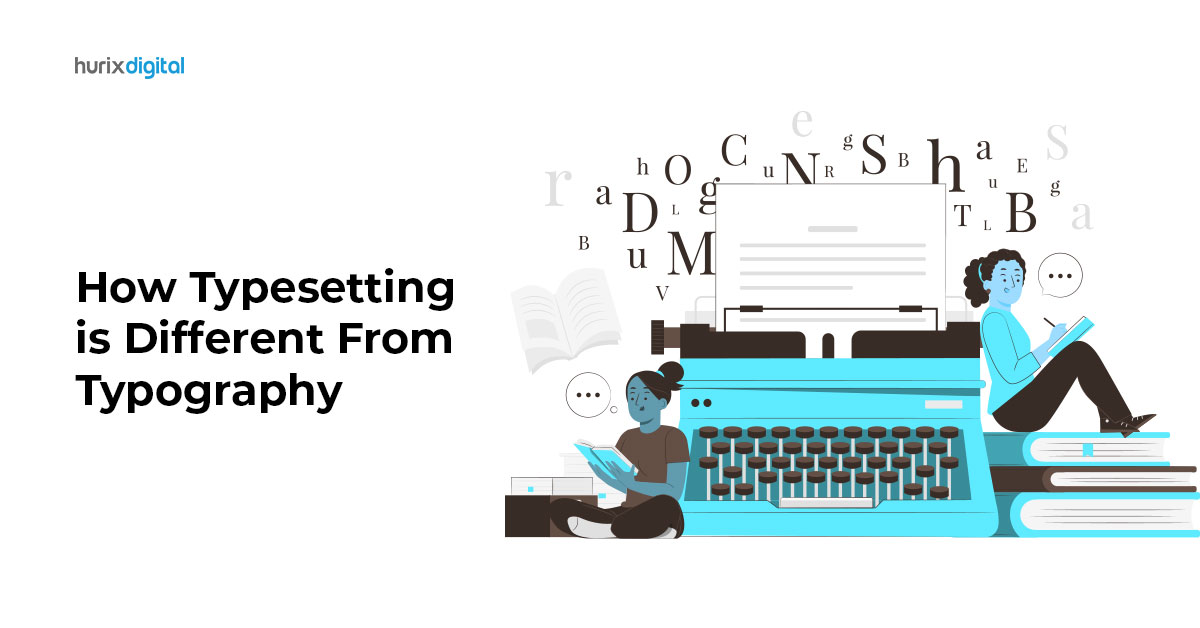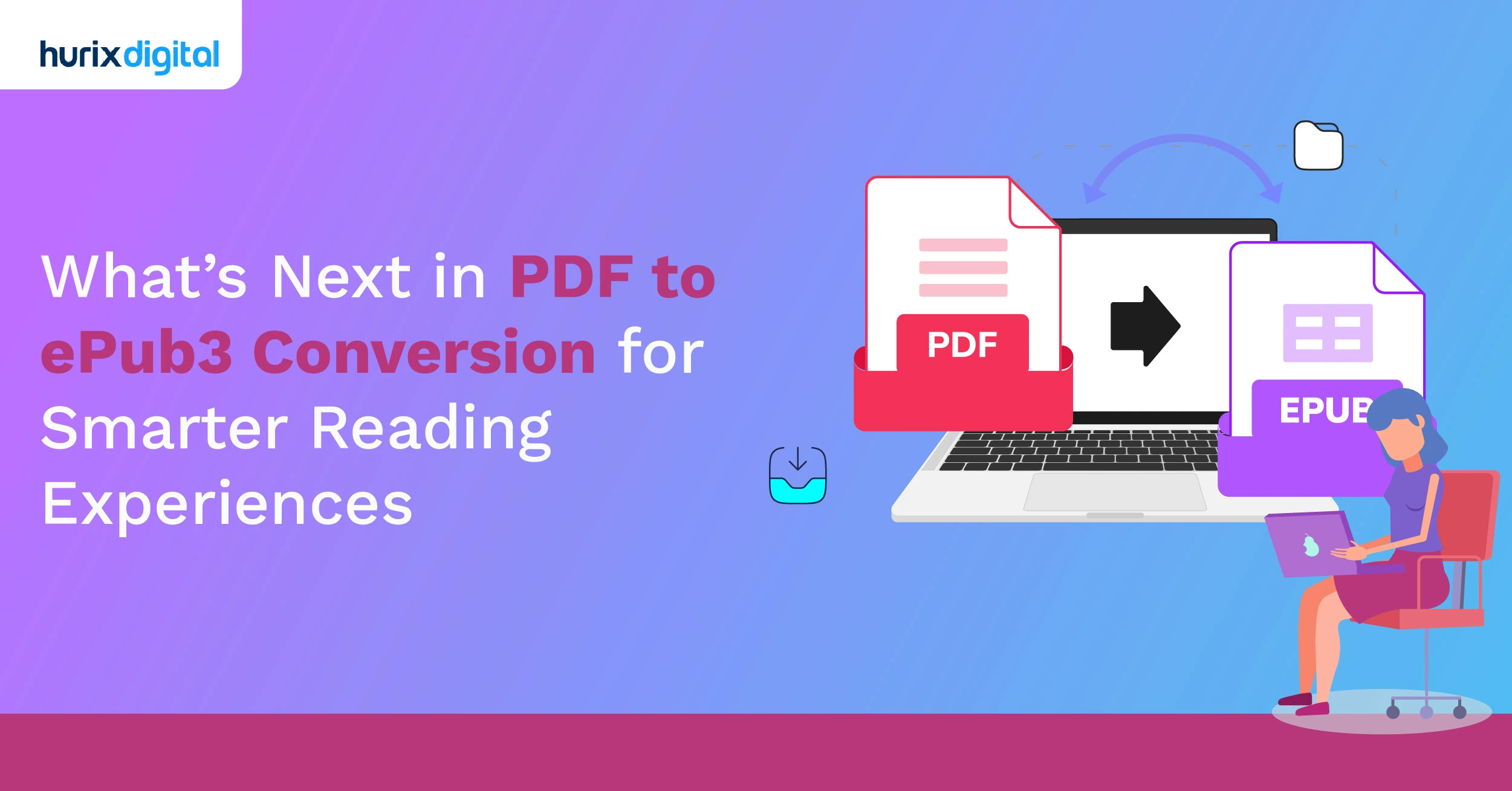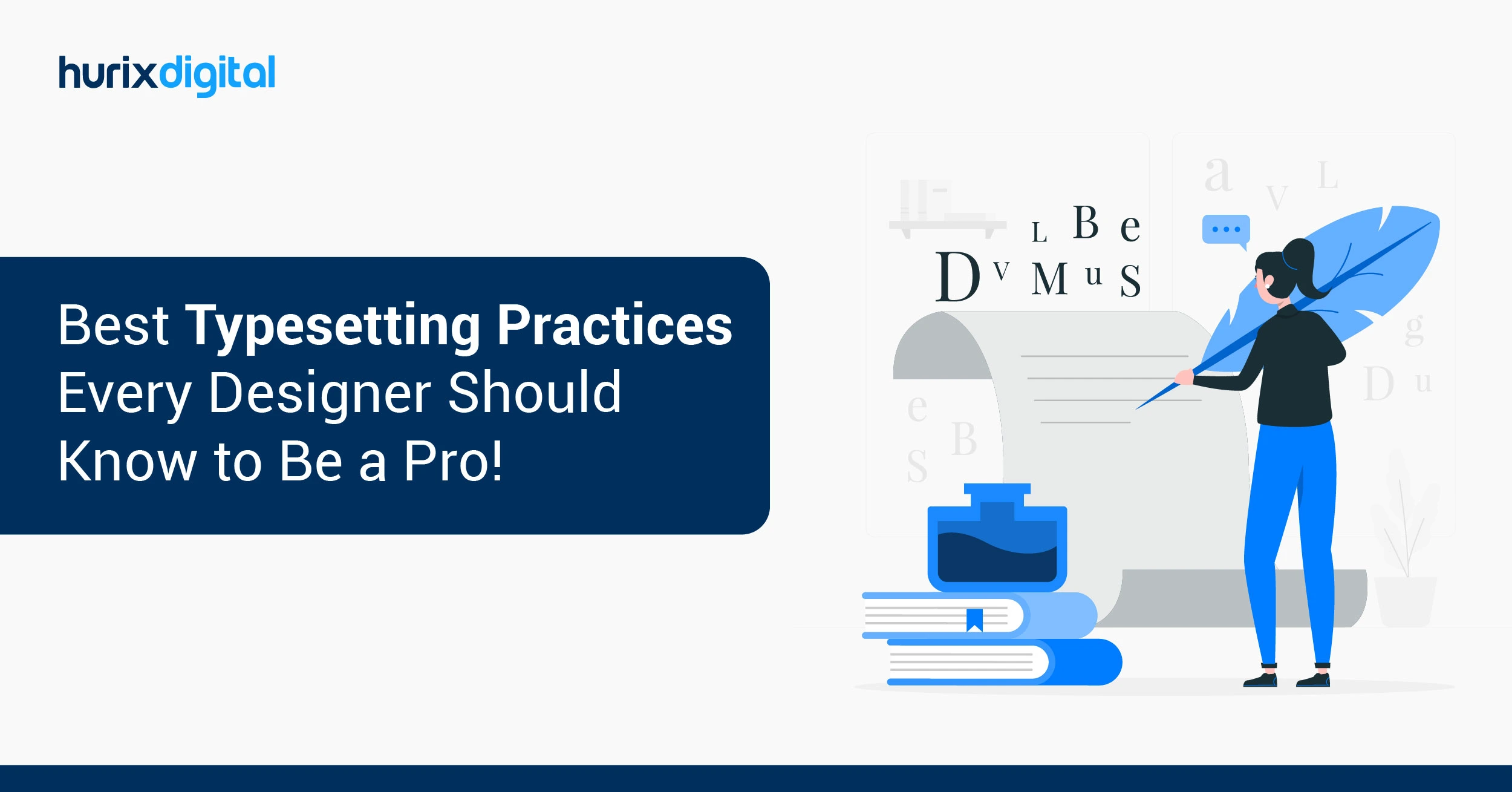
Best Typesetting Practices Every Designer Should Know to Be a Pro
Summarize with:
Typesetting, the art of arranging text elements, often takes a backseat in ebook design discussions. However, this seemingly technical craft holds immense power in shaping a project’s visual impact, readability, and overall user experience. In the context of ebook design, where over 90% of content is text-based, effective typesetting plays a pivotal role in delivering an engaging and accessible reading experience.
From websites and brochures to packaging and presentations, mastering the art of typesetting and ebook design unlocks your ability to create visually striking and user-friendly layouts.
We will go deeper into the world of typesetting, equipping designers with best practices, essential design principles, and practical tips.
Table of Contents:
- What is Typesetting in Publishing?
- Elements of Typesetting That Transform Content Appeal
- Benefits of Typesetting
- Five Essential Typesetting Rules for a Polished Book
- Effective Typesetting Tricks You Must Remember
- 8 Practical Tips for Mastering Typesetting
- Summing Up
What is Typesetting in Publishing?
Typesetting is the meticulous process of arranging the physical or digital elements of a book, including letters, symbols, and glyphs, into a format suitable for printing. This stage occurs after the manuscript has undergone editing and precedes the actual printing.
It involves critical decisions about font selection, chapter styles, and graphic positioning to create the best possible book layout.
Typesetting is not merely about aesthetic appeal; it directly impacts readability and the overall reader experience. The choice of font, spacing, and margin sizes are made carefully considering genre and audience. In graphic design and publishing, typesetting is a sophisticated art form combining technical proficiency with creative vision.
Therefore, typesetting remains a specialized and challenging aspect of ebook design, integral to producing a professional and reader-friendly publication.
Elements of Typesetting That Transform Content Appeal
Despite the many graphic design trends, typesetting silently and unchangingly carries a great deal of weightage.
To better explain how much ripple typesetting can create in the process of enhancing your content’s appeal and readability, here are the elements of typesetting that deliver its transformative power.

1. Aiding a Visual Story with Font Dynamics
The font dynamics of typesetting have the power to help tell a story. The ideal font size and format, the weightage of each line, and even the right pairing of different fonts help communicate the tone of your content.
Through thoughtful typeface selection, font dynamics have the potential to add depth and intent to each word, guiding the reader through a more engaging and visual narrative. In dynamic animations on web pages, a responsive design heavily depends on font dynamics to grab a viewer’s attention.
2. Developing a Thought Train with Hierarchy and Focus
Structure is a crucial element that helps a reader navigate through content. Typesetting also includes organizing content and giving it shape and a visual hierarchy. This facilitates controlling a narrative and maintains a clear train of thought while reading content.
Effective typesetting gives the readers an uninterrupted and focused experience with the piece. This power of typesetting helps to keep the context and content on point.
3. Easing Content Readability with Mastery of Spacing
Keeping your eyes scrunched while reading content is the quickest way to get a headache. Typesetting includes the text alignment between lines and even words. The result from a survey sheds quite some light on the impact of text alignment on readability and also reading accuracy.
Thoughtful and deliberate line spacing tremendously eases readability and avoids visual clutter, while kerning—the adjustment of space between letters and words—gives the content balance and visual appeal.
4. Alluring Viewers with the Perfect Layout
Typesetting plays a massive role in a brand’s theme amidst the many layout innovations that continue to grow based on user preferences. The right layout lures viewers and boosts web traffic.
Typesetting is a distinct art form that creates a harmonious experience, elevates aesthetic appeal, and prevents visual fatigue. Page layout delves into the nitty-gritty of the ideal column width and margins and the more prominent aspects, such as content arrangement and purposeful white space.
5. Maintaining the Engagement Through Color Theory
It is a known fact that colors have the potential to calm or excite. With effective typesetting, the ideal color palette, contrast, and legibility can invigorate readers while they experience the content.
Typesetting also involves the creative use of color, which can highlight and focus on information and evoke specific atmospheres. Its careful management improves readability and helps the content reach its readers by being visually striking and engaging.
Benefits of Typesetting
Typesetting is ideal for both printed and digital content, but for eBooks, it can be a crucial step in making your end output look spectacular. Some of the key advantages of book typesetting include the following:
- Enhanced Readability: A document that is well-designed and effectively typeset enhances its overall readability. Proper fonts, sizes, line spacing, and markings make the eBook look polished and inviting, ensuring readers can easily navigate and read text.
- Polished Appearance: A well-typeset document exudes professionalism. This gives it a distinct flavor and a polished look. Using consistent fonts, styles, and layouts also helps improve the impression of your materials. This is crucial for any digital brand since first impressions on readers usually last.
- Provides Clear Visual Hierarchy: Typesetting allows for the creation of a visual hierarchy within the text. Important information can be emphasized by adjusting font styles, sizes, and spacing, guiding readers’ attention and understanding. This enables users to skim through the document, which is ideal in today’s world, where most readers have limited time to read large documents.
- Makes Documents Accessible: Proper typesetting practices take into account accessibility considerations. By including well-structured text with appropriate fonts, spacing, and high color contrast, readers with visual impairments or reading difficulties can easily consume the content. It also ensures that if the font needs to be increased for better readability, the document’s layout doesn’t get out of alignment.
- Reduced Eye Strain: Carefully typeset content reduces eye strain that can arise due to prolonged reading sessions. Readers can have a comfortable reading experience in print or digital formats with appropriate line lengths and spacing.
Five Essential Typesetting Rules for a Polished Book

Even if you are not a professional book designer, there are a few easy ways you can improve the visual appeal of your book’s layout and design.
Pick up any bestseller out of your bookshelf, and you’ll notice many typesetting examples around the following principles in play. Put them to use for yourself, and your book will find its place among the best.
Below are five straightforward typesetting rules that can significantly enhance the appearance and readability of your book:
1. Leave Enough Margin Space
Technically a blank space, the margin is perhaps the most important element of book layout. A typical book page features three distinct margins: the outside, top, and bottom, as well as a gutter, which is the inner margin where pages bind. Every margin serves a specific purpose; for example, the outside margins allow the reader’s thumbs to rest comfortably when holding the book.
The top margin hosts the author’s name, chapter/book title, and sometimes even page number, while the bottom margin offers a cushion of white space for the text block. The gutter ensures that the text remains clear of the binding area.
Conventionally, the outside, top, and bottom margins maintain similar sizes, approximately half an inch, with the gutter being the widest, generally .75 to .9 inches.
2. Incorporate Running Heads and Feet
Every page in the book has a little heading above the main text block called Running Heads. They are placed to anchor the text and, most necessarily, help readers navigate through the book. A running head typically contains information, usually the book’s title, the author’s name, and sometimes, the chapter title.
The header can be centered, or the text can be aligned to the inside margin with the page numbers in the outside margin.
Sometimes, page numbers are displayed below the text block in the footer rather than in the header. These small decisions can have a major impact on how your pages look and on the overall book design, underscoring the importance of effective typesetting and book design.
3. Select Your Trim Size Carefully
The term “trim size” describes a document’s dimensions after it undergoes printing and cutting but before any folding or binding. Though there are no rigid rules concerning trim size when it comes to books, there are a few general trends.
Trim sizes are consistently expressed in inches, with the horizontal and vertical measurements coming first.
The standard book sizes are 5.5 x 8.5 and 6 x 9, which work for books of almost any style. Your lower limit should ideally be 5 × 8 as anything smaller can make your book look inelegant.
4. Align Your Paragraphs Correctly
There are two primary types of alignments for paragraphs in books: “justified” and “ragged right.”
You may have observed that the paragraph in the traditional style of book publishing is always justified and aligned, whether it’s a professional book or written material.
This choice imparts a formal, easily readable feel, making it well-suited for lengthy texts. Conversely, shorter content, such as pamphlets or brochures, typically employs “ragged right” alignment to enhance readability.
So, the decision rests with you and is based on the kind of book you wish to publish. Choose what readers can readily adapt to.
5. Choose the Right Font Type
The font should be readable. It should not only be attractive at first glance but comfortable to read over a hundred pages or more. In the book world, fonts like Garamond, Janson, Caslon, or Minion have a long-standing history, and you can see them everywhere.
They cluster letters together to make it easier to recognize them as words, guiding the eye along a line of type. Any of these fonts is a great choice in typesetting and book design.
Furthermore, you can always choose a less lively font that is easy to read in paragraphs. Never be scared to be “boring.” The text should be visible when reading, not the typeface. Choosing a more vibrant font for your cover, title page, chapter titles, and other accents is a great way to constantly add some zing.
Adhering to these basic typesetting rules for books can significantly improve your page design with just a little effort.
Effective Typesetting Tricks You Must Remember
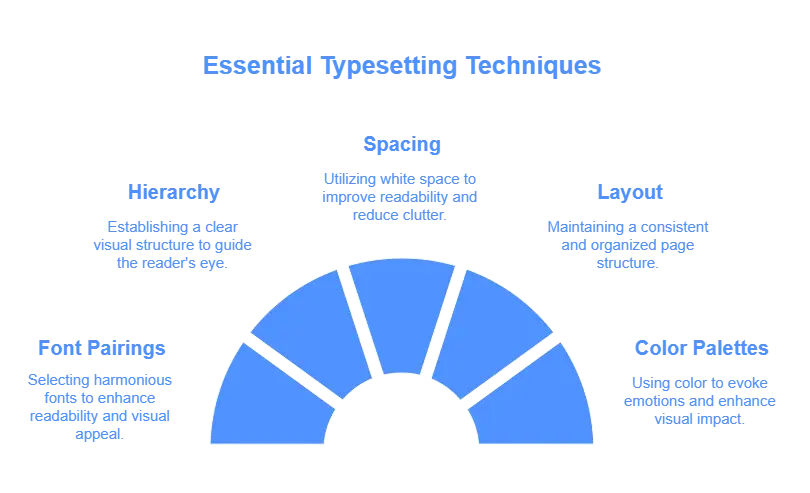
With each element of typesetting holding so much potential, it’s crucial to have the right blend of tricks under your belt to boost the aesthetics and readability of your content!
Here are practices packed with typography principles that enhance the visual appeal of your content:
1. The Right Font Pairings
Choose fonts that complement each other. Font pairing is instrumental in conveying the intended tone of the message and keeping your reader’s engagement high with your content.
2. Crisp and Clear Hierarchy
Communicate the structure of your piece clearly with uniform font size, weight, and style. Use appropriate headings, subheadings, and text to guide your readers to grasp essential information seamlessly.
3. Space Your Content
Fine-tune line spacing and kerning to ease readability and deliver professional content. Amongst most designers, the ideal line spacing for readability is between 1.3-1.5.
4. Maintain Your Page Layout
Ensure your layout is consistent across pages and aligned with your brand theme. It is also important to understand that your canvas differs and space changes when deciding between print vs. digital typesetting. With the help of uniformity, the page layout can prevent readers from getting distracted.
5. Control Your Appeal with Colour Pallets
Based on your content, intent, and messaging, select a color pairing that best suits your brand and message. For example, when emphasizing content and minimalism, monochrome themes with high contrast fit best; if your messaging is environmental, earthy tones like brown, yellow, and green help.
Check Out EXCLUSIVE: Hurix Mini-Book: PrePress Tips You Won’t Find Anywhere Else
8 Practical Tips for Mastering Typesetting
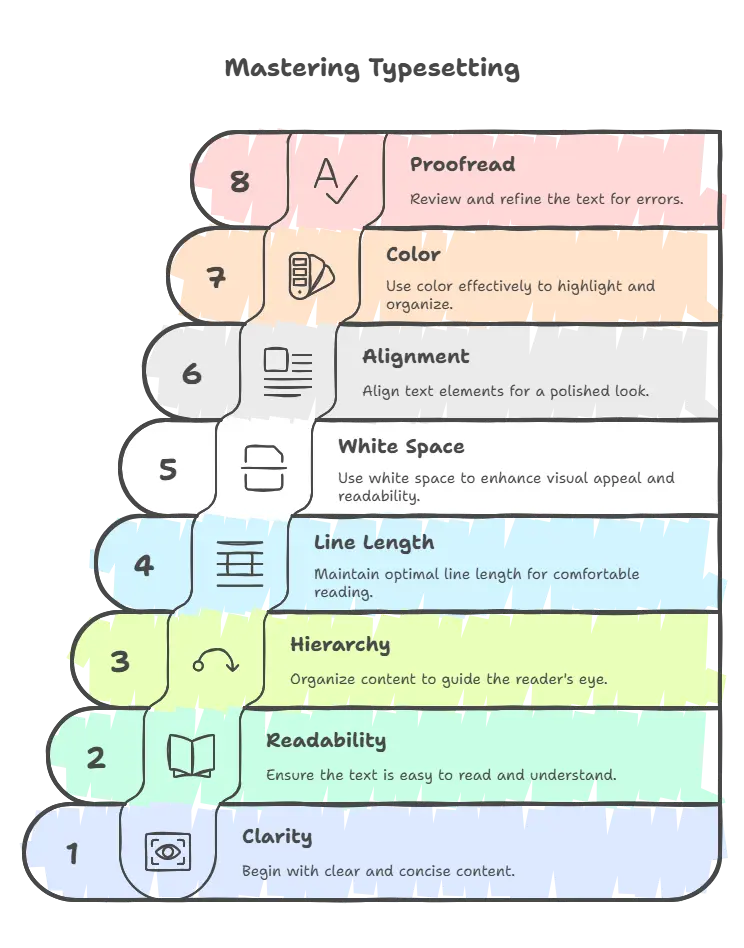
The journey to mastering typesetting is a continuous exploration, so embrace the learning process and let your creativity flourish.
Now that you understand the principles, here are actionable tips to elevate your typesetting skills:
1. Start with Clarity
Define the purpose of your design and the message you want to convey. Choose fonts that are appropriate for your target audience and brand identity.
2. Understand Readability
Prioritize clear, easy-to-read fonts. Avoid tiny fonts or overly ornate styles that can hinder user experience.
3. Utilize Hierarchy
Implement contrasting sizes and weights to guide the reader’s eye through your design. Emphasize key information with larger fonts or bolding.
4. Mind the Line Length
Aim for line lengths that are comfortable for the reader’s eye. Avoid excessively long lines that can cause fatigue and hinder reading flow.
5. Embrace White Space
Don’t fear space! Utilize white space strategically to create visual breathing room and enhance the visual impact of your text elements.
6. Pay Attention to Alignment
Consistent alignment of text elements signifies professionalism and visual order. Ensure headlines, paragraphs, and bullet points are aligned for a polished look.
7. Harness the Power of Color
Utilize color strategically to create visual interest and reinforce hierarchy.
8. Proofread and Refine
Always proofread your text for any typos or grammatical errors. Make adjustments to spacing, kerning, and alignment for a polished final product.
Summing Up
A solid layout is the result of numerous small design decisions. Whether it’s selecting the right leading, choosing the perfect font, or determining the appropriate margin size, the key principle is unwavering consistency. If you make a design choice on page three, commit to it for the entire two hundred pages and beyond.
34% of website visitors leave due to poorly designed and difficult-to-read layouts. While the design’s visual appeal is undeniable, effective typesetting goes beyond mere aesthetics. It plays a crucial role in communication and user experience.
If you are looking for a partner to transform your typesetting processes or need guidance on adhering to industry-standard typesetting guidelines, Hurix Digital is here to help you achieve the optimum page design.
Contact us to discover how we can help you integrate our knowledge to create layouts that are both functional and visually captivating.
Summarize with:

Vice President – Content Transformation at HurixDigital, based in Chennai. With nearly 20 years in digital content, he leads large-scale transformation and accessibility initiatives. A frequent presenter (e.g., London Book Fair 2025), Gokulnath drives AI-powered publishing solutions and inclusive content strategies for global clients
 Upcoming Masterclass | Build an Army of Brand Evangelists using Training & Development | November 20th, 8:30 AM PDT | 11:30 AM EDT | 10:00 PM IST
Upcoming Masterclass | Build an Army of Brand Evangelists using Training & Development | November 20th, 8:30 AM PDT | 11:30 AM EDT | 10:00 PM IST

